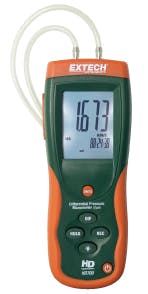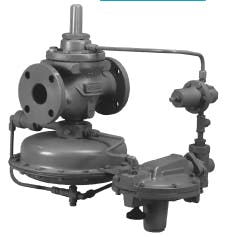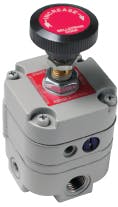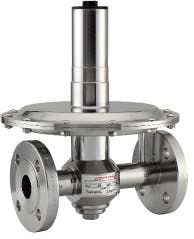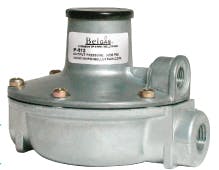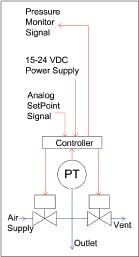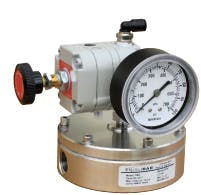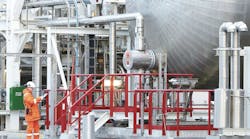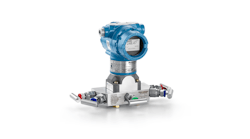Most engineers are comfortable working with pressures above 1 PSIG (69 mbar), but are often confused about the best way to control much lower pressures, typically expressed in inches of water column (1 PSIG = 27.7 in.H2O). There are dozens of industrial applications for low and ultra-low pressure. Some common examples are:
• Tank nitrogen padding or blanketing
• Product integrity testing
• Glove boxes
• Fuel burner systems
• Tubing die extrusion control
While specific product solutions have been developed to address the common applications listed above, it can be confusing for the engineer or scientist to know how best to address their special application requirements. For example, their pressure range, flowrate, accuracy requirements, or automation requirements make it difficult to select the right pressure control approach.
This article describes several traditional and emerging pressure control methods in this low-pressure range, both manual and computer automated. For the purposes of this article, we can define “low pressure” as below 1 PSIG (69 mbar) and “ultra-low pressure” as below 0.1 PSIG (3 in.H2O, 7 mbar).
Precision Air Regulators
Applications: Instrumentation & Actuation
There are numerous precision air regulators targeted at instrumentation applications in the range of 1/8” or 1/4” pipe. Several of these can control pressures below 1 PSIG (69 mbar), though no commonly available solutions are precise in the ultra-low range. These regulators typically are self-relieving, meaning they can vent downstream air when the setpoint is lowered or if the downstream pressure exceeds the setpoint. In addition, most of these have a slight consumption (or weep of air), which gives them more precision and stability.
Dual-stage servo pressure regulators have set a gold standard in terms of small air regulator precision in the range down to 0.5 PSIG (35 mbar). These regulators utilize a dual-stage servo mechanism to virtually eliminate droop with varying flowrates. They are available in ranges from 0.5 PSIG to 25 PSIG (35 to 1,724 mbar) and up to 120 PSIG (8.3 bar). Unfortunately, the stainless steel capsule used in these designs does not allow for any setpoint below 0.5 PSIG, limiting the usefulness of this device in these sort of applications.
Simpler single-stage regulators can easily control pressure down to zero PSIG for short-term applications. These commonly come in pressure ranges as low as zero PSIG to 2 PSIG (138 mbar). Because of their extreme sensitivity, they can be used for short-term pressure settings down to the range of 0.25 in.H2O (0.6 mbar). However, experience shows that these regulators have limited long-term stability at pressures below 6 in.H2O (15 mbar). Settings below 3 in.H2O (7 mbar) are definitely not practical for a long duration due to drift.
It is a good idea to maintain filter regulators upstream of any precision air regulator to provide stable inlet pressures and to remove moisture and particulate. Single-stage regulators are especially dependent on stable inlet pressures for good performance.
High Flow/Low Pressure Regulators
Applications: Tank Blanketing Regulators
At the high flow end of the spectrum, control valves are often outfitted with pilot-actuated feedback systems to provide control at pressures down to 0.25 in.H2O. These systems can be quite complex and involve up to three separate regulating mechanisms. While this solution is desirable for the many large tank-blanketing systems, the size and complexity would be prohibitive for most lower-flow applications.
Single-stage tank blanketing regulators are simpler and more suitable for smaller installations, and are available in smaller sizes such as one-inch and half-inch pipe. These single-stage regulators can control down to 2 in.H2O (5 mbar) with excellent sensitivity.
Propane & Natural Gas Regulators
The propane and natural gas industries have developed a simpler form of pressure-reducing regulator that functions down to about 3 in.H2O (7 mbar). Single-stage regulators use relatively large rubber diaphragms to generate enough actuating forces to control in these low-pressure ranges. Often a lever arm is used to magnify the forces from the diaphragm to provide adequate force to control the inlet valve. These fuel regulators are available in sizes of 1/4” and larger.
Electronic Pressure Regulators
Electronic pressure regulators, often called electro-pneumatic regulators (EPRs), control pressure by adjusting valves in response to a pressure sensor. One very common form of EPR is the servo-electronic pressure regulator. A major advantage to the servo EPR is that it can be used for both low pressure and ultra-low pressure applications (down to zero to 4 in.H2O [10 mbar]) just as easily as the more common industrial pressure ranges, such as 3-15 PSIG, 0-100 PSIG, etc.) (207-1,034 mbar and 0-7 bar).
Servo electronic pressure regulators work by using a push (inlet) valve and a vent valve to maintain the outlet pressure at the desired setpoint. A small internal pressure sensor monitors the output pressure, and a digital or analog controller adjusts the timing of the servo valves to maintain the pressure very near setpoint.
These EPRs typically require a DC power supply and a setpoint signal. Analog controllers typically accept either current (4-20 mA) or voltage (typically 0-10 or 0-5 VDC) input. Models with digital circuits can accept serial communications (such as RS-232 or DeviceNet) in addition to the common analog standards. Most models also offer a feedback signal reporting on the pressure sensor value.
Most EPR manufacturers also offer a two-loop option, which accepts an external sensor input and controls the output pressure to resolve the external sensor to the desired setpoint value.
One advantage of the servo EPR is that it can theoretically operate down to the lowest pressure range of available pressure transmitters. Several industrial EPR manufacturers offer standard models down to 0-1 PSIG (0- 69 mbar) range, and claim accuracies in the range of 0.5 percent full scale. A few manufacturers offer full-scale ranges down to 0-10 in.H2O (0-25 mbar) and even 0-4 in.H2O (0-10 mbar).
One disadvantage of the servo EPR is that the binary valve action can result in jittery or uneven pressure output if not tuned carefully to the system dynamics. An improved hybrid EPR design has recently been developed that allows the push valve to partially open. By combining this analog push valve action with a small bleed, these innovative EPRs are able to provide incredible resolution (as high as 0.005 percent), quietness, and stability to their ultra-low pressure control.
Specialized Systems for Extrusion Control
Specialized systems have been developed to provide low-pressure control specifically for tubing extrusion systems. These systems utilize sensitive spring regulators, but also have the ability to include closed-loop feedback control and electronic setpoint automation. Commonly available systems control pressure down to 0-2 in.H2O (0-5 mbar) range, with flowrates up to 5 SCFH (2.4 SLPM).
Calibration-Class Pressure Controllers
Not surprisingly, the highest precision and stability in pressure control is marketed for calibration applications. These calibrators typically sell in the range of $3000 to $10,000 and offer very high sensitivity and stability by controlling pressure in response to high-end pressure transmitters. This class of controllers is intended for very low flowrates (static or nearly so). These devices boast precision as high as 0.005 percent reading + 0.005 percent full scale and can auto-range to pressures as low as 0-10 in.H2O (0-25 mbar).
Dome-Loaded Pressure Regulators
While the precision air regulators and electronic pressure regulators above are able to economically provide for very low-pressure control, they are both limited in maximum flowrate. A dome-loaded pressure regulator is often used as a type of flow amplifier, taking the precision signal from the smaller regulator, and relaying it into a larger process stream. This can be done with either open-loop or closed-loop control (where a PID controller adjusts the signal pressure in response to the error sensed by a process pressure transmitter).
Another major reason to use a dome-loaded pressure regulator is to achieve chemical isolation between a process stream and the signal instruments. For example, a flammable or corrosive gas stream is not typically suitable for use with precision pressure regulators or electronic pressure regulators. A dome-loaded regulator can be used to separate the “clean” instruments from the “dirty” process.
While there are few if any pressure-reducing dome-loaded regulators suitable for the ultra-low pressure range, a new ultra-sensitive back pressure regulator can provide excellent control down to the 0.5 in.H2O (1 mbar) range. These devices are sensitive to changes as small as 0.01 in.H2O (0.02 mbar).
While most users think in terms of pressure-reducing regulators, many applications can be reconfigured to take advantage of the ultra-sensitivity available from these dome-loaded back pressure regulators. For example, a sensitive back pressure regulator can be used to vent off excess gas supply from a rotameter or metering valve, as in the example illustrated above.
Jeff Jennings is founder and president of Equilibar LLC, a provider of high-precision and low-pressure control solutions. Prior to Equilibar, he worked as a process development engineer for 23 years. He is a licensed professional engineer in North Carolina and holds several patents. Mr. Jennings can be reached at [email protected] or 828 650-6590.

